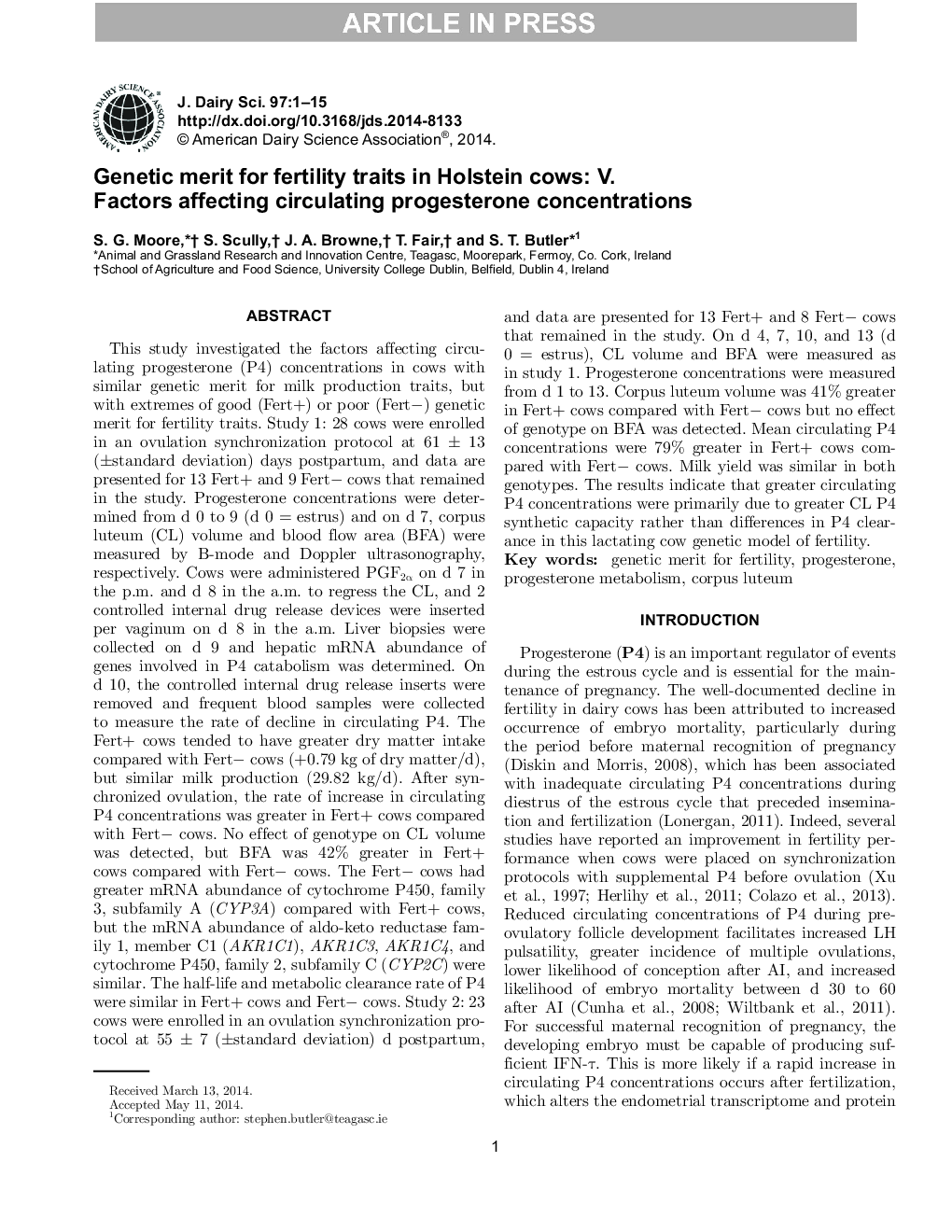| کد مقاله | کد نشریه | سال انتشار | مقاله انگلیسی | نسخه تمام متن |
|---|---|---|---|---|
| 10974119 | 1108022 | 2014 | 15 صفحه PDF | دانلود رایگان |
عنوان انگلیسی مقاله ISI
Genetic merit for fertility traits in Holstein cows: V. Factors affecting circulating progesterone concentrations
دانلود مقاله + سفارش ترجمه
دانلود مقاله ISI انگلیسی
رایگان برای ایرانیان
کلمات کلیدی
موضوعات مرتبط
علوم زیستی و بیوفناوری
علوم کشاورزی و بیولوژیک
علوم دامی و جانورشناسی
پیش نمایش صفحه اول مقاله

چکیده انگلیسی
This study investigated the factors affecting circulating progesterone (P4) concentrations in cows with similar genetic merit for milk production traits, but with extremes of good (Fert+) or poor (Fertâ) genetic merit for fertility traits. Study 1: 28 cows were enrolled in an ovulation synchronization protocol at 61 ± 13 (±standard deviation) days postpartum, and data are presented for 13 Fert+ and 9 Fertâ cows that remained in the study. Progesterone concentrations were determined from d 0 to 9 (d 0 = estrus) and on d 7, corpus luteum (CL) volume and blood flow area (BFA) were measured by B-mode and Doppler ultrasonography, respectively. Cows were administered PGF2α on d 7 in the p.m. and d 8 in the a.m. to regress the CL, and 2 controlled internal drug release devices were inserted per vaginum on d 8 in the a.m. Liver biopsies were collected on d 9 and hepatic mRNA abundance of genes involved in P4 catabolism was determined. On d 10, the controlled internal drug release inserts were removed and frequent blood samples were collected to measure the rate of decline in circulating P4. The Fert+ cows tended to have greater dry matter intake compared with Fertâ cows (+0.79 kg of dry matter/d), but similar milk production (29.82 kg/d). After synchronized ovulation, the rate of increase in circulating P4 concentrations was greater in Fert+ cows compared with Fertâ cows. No effect of genotype on CL volume was detected, but BFA was 42% greater in Fert+ cows compared with Fertâ cows. The Fertâ cows had greater mRNA abundance of cytochrome P450, family 3, subfamily A (CYP3A) compared with Fert+ cows, but the mRNA abundance of aldo-keto reductase family 1, member C1 (AKR1C1), AKR1C3, AKR1C4, and cytochrome P450, family 2, subfamily C (CYP2C) were similar. The half-life and metabolic clearance rate of P4 were similar in Fert+ cows and Fertâ cows. Study 2: 23 cows were enrolled in an ovulation synchronization protocol at 55 ± 7 (±standard deviation) d postpartum, and data are presented for 13 Fert+ and 8 Fertâ cows that remained in the study. On d 4, 7, 10, and 13 (d 0 = estrus), CL volume and BFA were measured as in study 1. Progesterone concentrations were measured from d 1 to 13. Corpus luteum volume was 41% greater in Fert+ cows compared with Fertâ cows but no effect of genotype on BFA was detected. Mean circulating P4 concentrations were 79% greater in Fert+ cows compared with Fertâ cows. Milk yield was similar in both genotypes. The results indicate that greater circulating P4 concentrations were primarily due to greater CL P4 synthetic capacity rather than differences in P4 clearance in this lactating cow genetic model of fertility.
ناشر
Database: Elsevier - ScienceDirect (ساینس دایرکت)
Journal: Journal of Dairy Science - Volume 97, Issue 9, September 2014, Pages 5543-5557
Journal: Journal of Dairy Science - Volume 97, Issue 9, September 2014, Pages 5543-5557
نویسندگان
S.G. Moore, S. Scully, J.A. Browne, T. Fair, S.T. Butler,